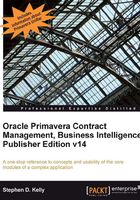
Types of project information
There is not enough space on these pages to list or explain the many types of information relating to a project. Some of these include a master contract, a task order relating to that master contract, a notice to proceed that allows the contractor to proceed while he or she waits for an official change order, notification documents that are official notices of an upcoming or past due event, and many more. Each of these documents provides an opportunity to record a date on which responses must be given or completion of the action must be taken. With this information, we can report on upcoming tasks that need our attention. Organizations use different acronyms and names for all the different types of documents. Every organization has its own language when talking about documents or information. When you see the word "budget" or "claim", you understand exactly what is meant by that term—or do you? You know what the term means to you and your organization, but do you know that other organizations see those terms through differently colored glasses? Those terms may mean something slightly or completely different. In some cases the term means the opposite of what you think. PCM allows you to change the terminology to match your organization so when a term is used in conversation or it is seen in PCM, it means the same thing.
PCM allows the organization to use its acronyms when defining all the different types of documents used for a project. The following screenshot shows a subset of the different acronyms and document types that are available out of the box when PCM is installed:

The Document Setup function lets the administrator define document acronyms to be available for use in your organization. This lets the system mirror your organization rather than a system where the organization needs to interpret what the system means. These acronyms can be used for information types sent out from the organization or all the different types of documents received by a project from outside parties. Being able to apply a document type to all documents received in or sent out from a project is the first level of organizing the data, that is, by document type.
For example, a document that a contractor sends out to its subcontractors requesting a price for a change in scope can be called several different things. It can be a Request for Proposal (RFP), it can be a Request for Quotation (RFQ), or it can be a Change Order Request (COR). Each organization needs to define each of these document types and standardize them. Your organization wants one document for a process and not to have every project manager call the example above whatever they want.
There must be a standard set by the organization as to what terms or language will be used within the organization.
When an organization contracts with another organization, there must be a meeting of the minds as to the language that will be spoken for the project. This many times ends up being a combination of the two organizations, but for a project to go smoothly all parties related to that project must speak the same language.

There are many places within PCM where a dictionary is used to help describe a document type or give it attributes that describe the document. Be careful when using these dictionaries as some of them are project specific while others are group specific.
This first level of document organization in many cases uses the modules within PCM as the repository for storage and retrieval of the documents. Each module in PCM has different attributes that provide the uniqueness of the document type or related types.
Understanding the document types and how they fit into the modules within PCM is the start to properly setting up PCM for your organization. You must become familiar with the different attributes of each module and be able to best relate those attributes to the attributes required of each document type. Each module has its own set of unique characteristics.
Customized text is available to change the text of the data entry field names as well as the tabs, error messages, and many other places. This will change the text for all projects, so this is organizational text versus project text. You must be careful with this functionality as well. When you change the word Date, it may change in places you did not expect.